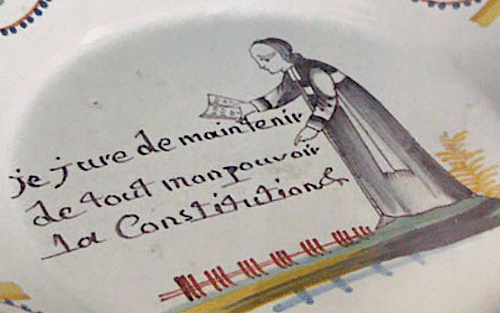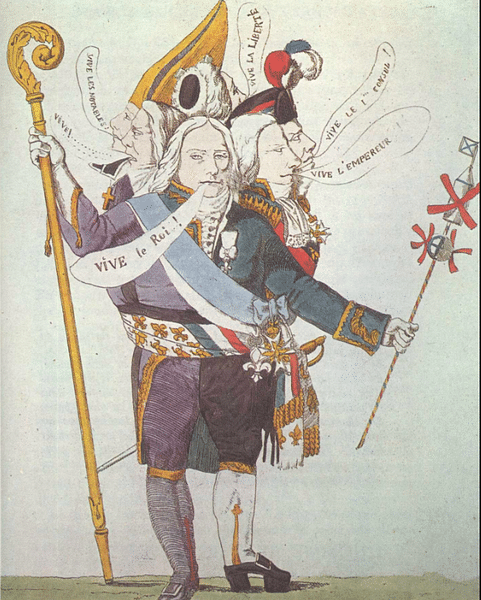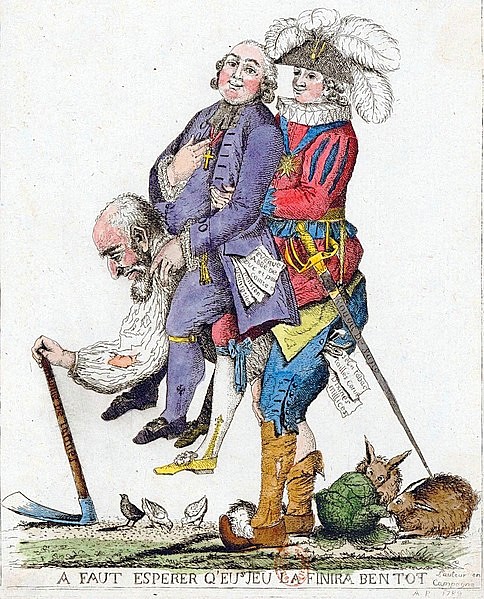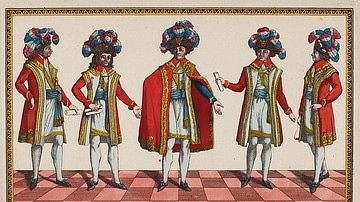
The Civil Constitution of the Clergy was a law passed in July 1790 during the French Revolution (1789-1799), which caused the immediate subordination of the Catholic Church in France to the French government. An attempt to modernize the Church and realign it with revolutionary values, the law proved highly divisive, turning many Catholics and clerics against the Revolution.
Clergy and the Revolution
“One of the opening assaults of the French Revolution was against the Church,” writes Alexis de Tocqueville, more than 50 years after the event. “Among the passions to which the Revolution gave life, the first to be kindled and the last to be extinguished, was the anti-religious” (21). Yet, as Tocqueville goes on to say, the Revolution had never intended to ignite this anti-religious spark, not even when it passed legislation that challenged the Church’s power. The main goal of the Revolution was to dismember the old regime and to replace it with a society based on social equality. The revolutionaries initially took on the Gallican Church, therefore, not out of any anti-Christian sentiment, but because the Church fundamentally stood in the way of this goal.
It is not difficult to see exactly how intertwined the Gallican Church (another name for the French Catholic Church) was with the Ancien Regime. On the eve of the Revolution, the Church enjoyed absolute religious hegemony within the boundaries of the Kingdom of France. Since the revocation of the Edict of Nantes in 1685, all French subjects were required by law to be Catholics, and the Church had a near monopoly on all education, poor relief, and hospitals, as well as vast powers of censorship. As the first order of the realm, the clergy technically outranked the nobility in the French hierarchy, with some of its more powerful members reaching high levels of political office. Even the power of the French monarch, frequently styled as “His Most Christian Majesty”, was closely tied with Church customs.
Still, when the Revolution erupted in May 1789, many clerics were not only supporters of the Revolution’s goals but active participants. Most notable was Abbé Emmanuel-Joseph Sieyès (1748-1836), who was one of the most avid supporters of the Third Estate (commoners) during the Estates-General of 1789, and who spearheaded the creation of the National Assembly. Other clerics, some of whom were low-born parish priests, also sympathized with the Third Estate and voted to join them even before King Louis XVI of France (r. 1774-1792) begrudgingly commanded them to. On the night of 4 August, as the Assembly moved to abolish feudalism, many of the clergy enthusiastically supported the abolition of the tithe, seeing it as a necessary sacrifice to advance the Revolution.
Yet, as the Revolution continued tearing down the Ancien Regime, it was perhaps inevitable that it would turn on the institution of the Church. Notably, one of the most important figures in the schism between Church and Revolution came from within the clergy itself.
Seizing Church Lands
Charles-Maurice de Talleyrand-Périgord (1754-1838), bishop of Autun, was already famous for his cynicism and cold-blooded ambition. He had entered an ecclesiastic career because his permanent limp had denied him any other way for social advancement, though, as an idolizer of Voltaire, he remained skeptical of many Church doctrines. By 1788, when he was ordained bishop of Autun at age 34, he was no more devout, nor any more loyal to the institution of the Church, than he had ever been; on Talleyrand, historian Simon Schama writes, “when his friends called him ‘Bishop’, it was usually with a grin on their faces as though enjoying an innocent joke” (483).

On 10 October 1789, during a debate concerning impending financial disaster, it was Talleyrand who first pointed to the vast bounty of Church properties that lay scattered throughout France. The Church, Talleyrand argued, were not proprietors in the sense of any other landowner in the kingdom. The lands had been given to them by the nation for a certain purpose, and now the nation needed them back, for its own survival. After all, as Talleyrand put it, “great dangers demanded equally drastic remedies” (Schama, 483).
Talleyrand’s clerical colleagues were appalled. He would soon be denounced from every French pulpit as a Judas, a devil, and an Antichrist. Yet, other deputies, such as the influential Honore-Gabriel Riqueti, comte de Mirabeau (1747-1791), supported this measure, and on 2 November the Assembly voted to seize vast quantities of Church land for the good of the state. Some radical clerics, such as Abbé Henri Gregoire, also supported this. However, it was too far for Abbé Sieyès, who denounced the decision not for any especially religious reason, but because he felt it violated the Declaration of the Rights of Man and of the Citizen, which stipulated a right to property for everyone including, Sieyès argued, the Church.
This decision by the Assembly, already controversial enough, was only the first step in its attack on the Church’s supremacy. On 13 February 1790, the Assembly voted not to recognize the legality of monastic vows taken by monks and nuns. Shortly thereafter, it abolished monasteries and convents which were viewed by the revolutionaries as “useless and parasitical” (Doyle, 140). Representatives of the Assembly, sporting revolutionary tricolor sashes, were soon dispatched to monasteries across the kingdom to ensure the government’s decrees were being carried out. At the same time, Talleyrand proposed the use of pastoral pulpits to disperse news of Assembly policies, in order to better ensure the flow of legitimate information into the superstitious countryside. Should these priests refuse to reiterate revolutionary dogma to their flock, the Assembly promised to remove their parishes and retract their voting rights. Such acts were coldly justified by Antoine Barnave: “The clergy only exists by the virtue of the nation, so if it chooses, the nation can destroy it” (Schama, 489).
Passage of the Civil Constitution
But an even larger attempt by the Assembly to muzzle the Church was still to come. Since August 1789, an ecclesiastical committee had been set-up with the goal of bringing the Gallican Church into alignment with the expressed principles of the Revolution. A third of the members on this committee were clergy, who began to stall proceedings when they realized how radical the proposed measures were becoming. The Assembly combatted this by adding 15 more non-clerics to the committee. By summer 1790, the committee turned its proposals over to the Assembly, which immediately accepted them without amendment on 12 July 1790. This, of course, was the Civil Constitution of the Clergy.
The Civil Constitution was meant to return the politicized institution of the Church to its original state, meaning the clergy would revert to nothing more than spiritual guardians. To do this, the Assembly made the Gallican Church subordinate to the French government. Title I of the Constitution dealt with the number of bishops, which was limited to 83 to match the number of French departments, and confirmed the abolition of monastic orders. Title II stipulated that all clerics were to be elected by the people, like any other public officials. No longer would the king or the pope make appointments to the clergy. Title III dealt with the salaries of clerics which, though increased in many cases, signified that members of the clergy were now employees paid by the state. Lastly, Title IV required all bishops to reside within their respective dioceses. Additionally, all clerics were obliged to swear oaths of loyalty to the state and to the forthcoming constitution.
Only seven bishops immediately swore the oath required by the Civil Constitution (one of these being Talleyrand). Most, however, were hesitant, as swearing complete loyalty to the state might put them in conflict with their duties to the pope or to God. In November 1790, the Assembly made it compulsory for every member of the clergy, down to the lowest parish priests, to swear the oath. Still, many held their breath, preferring to hear the pope’s reaction before committing to anything.
The Pope Reacts
By this point, Pope Pius VI (r. 1775-99) already viewed the Revolution unfavorably; the Declaration of the Rights of Man had refused to acknowledge Catholicism as France’s official state religion, while a pro-French party in the papal-controlled city of Avignon was gaining influence, threatening to annex the city with France. As soon as word of the Civil Constitution reached Pius, he privately denounced it, writing to King Louis XVI in July 1790 to ask him not to sanction it. Yet by then, it was too late.
Although Louis XVI was a devoutly Catholic monarch, he had already agreed to sanction the document, albeit with great reluctance, in order to avoid a schism within his kingdom. For this reason, French ecclesiastics bombarded Rome with letters, asking the pope to not condemn the Constitution for the sake of French religious and political unity. For a while, Pius VI remained silent on the matter. But in March 1791, it seemed he could no longer hold his tongue, as he publicly condemned the Constitution and the French Revolution in general. In his remarks, Pius claimed the Revolution was making war on the Catholic Church and that Louis XVI had sanctioned the Constitution out of duress.
This response alarmed many of the French clerics who had taken the oath, who now tried to retract it. Many others continued to deny the Civil Constitution and carried on their religious duties regardless of the Assembly’s decrees. Yet, by early 1791, the oath had been taken by 60% of parish priests. Those who had taken the oath were henceforth known as “juring priests”, while those who refused were called “non-juring” priests. The non-jurors were especially prevalent in the countryside, and in regions such as Flanders, Brittany, and the Vendée.
The Civil Constitution was one of the first major points of division in the French Revolution. Clerics and devout Catholics who may have been supportive of the Revolution at first now had to choose between their faith and the Revolution. In areas like Paris, resistance by some clerics caused increased hostility against members of the Church, with clerical deputies in the Assembly being angrily shouted down by onlookers. The division would only worsen, and would intensify into the program of de-Christianization during the French Revolution.
Civil Constitution of the Clergy
Below is the text of the Civil Constitution of the Clergy, passed by the National Constituent Assembly on 12 July 1790 (from the Hanover Texts Historical Project):
Title I
ARTICLE I. Each department shall form a single diocese, and each diocese shall have the same extent and the same limits as the department.
II. The seat of the bishoprics of the eighty-three departments of the kingdom shall be established as follows: that of the department of the Lower Seine at Rouen; that of the department of Calvados at Bayeux.
All other bishoprics in the eighty-three departments of the kingdom, which are not included by name in the present article, are, and forever shall be, abolished.
The kingdom shall be divided into ten metropolitan districts of which the sees shall be situated at Rouen, Rheims, Besancon, Rennes, Paris, Bourges, Bordeaux, Toulouse, Aix, and Lyons. These archbishoprics shall have the following denominations: that of Rouen shall be called the Archbishopric of the Coast of the Channel.
IV. No church or parish of France nor any French citizen may acknowledge upon any occasion, or upon any pretext whatsoever, the authority of an ordinary bishop or of an archbishop whose see shall be under the supremacy of a foreign power, nor that of his representatives residing in France or elsewhere; without prejudice, however, to the unity of the faith and the intercourse which shall be maintained with the visible head of the universal Church, as hereafter provided.
VI. A new arrangement and division of all the parishes of the kingdom shall be undertaken immediately in concert with the bishop and the district administration.
XX. All titles and offices other than those mentioned in the present constitution, dignities, canonries, prebends, half prebends, chapels, chaplainships, both in cathedral and collegiate churches, all regular and secular chapters for either sex, abbacies and priorships, both regular and in commendam, for either sex, as well as all other benefices and prestimonies in general, of whatever kind or denomination, are from the day of this decree extinguished and abolished and shall never be reestablished in any form.
Title II
ARTICLE I. Beginning with the day of publication of the present decree, there shall be but one mode of choosing bishops and parish priests, namely that of election.
II. All elections shall be by ballot and shall be decided by the absolute majority of the votes.
III. The election of bishops shall take place according to the forms and by the electoral body designated in the decree of December 22, 1789, for the election of members of the departmental assembly.
VI. The election of a bishop can only take place or be undertaken upon Sunday, in the principal church of the chief town of the department, at the close of the parish mass, at which all the electors are required to be present.
VII. In order to be eligible to a bishopric, one must have fulfilled for fifteen years at least the duties of the church ministry in the diocese, as a parish priest, officiating minister, or curate, or as superior, or as directing vicar of the seminary.
XIX. The new bishop may not apply to the pope for any form of confirmation, but shall write to him, as to the visible head of the universal Church, as a testimony to the unity of faith and communion maintained with him.
XXI. Before the ceremony of consecration begins, the bishop elect shall take a solemn oath, in the presence of the municipal officers, of the people, and of the clergy, to guard with care the faithful of his diocese who are confided to him, to be loyal to the nation, the law, and the king, and to support with all his power the constitution decreed by the National Assembly and accepted by the king.
XXV. The election of the parish priests shall take place according to the forms and by the electors designated in the decree of December 22, 1789, for the election of members of the administrative assembly of the district.
XL. Bishoprics and cures shall be looked upon as vacant until those elected to fill them shall have taken the oath above mentioned.
Title III
ARTICLE I. The ministers of religion, performing as they do the first and most important functions of society and forced to live continuously in the place where they discharge the offices to which they have been called by the confidence of the people, shall be supported by the nation.
II. Every bishop, priest, and officiating clergyman in a chapel of ease shall be furnished with a suitable dwelling, on condition, however, that the occupant shall make all the necessary current repairs. This shall not affect at present, in any way, those parishes where the priest now receives a money equivalent instead of his dwelling. The departments shall, moreover, have cognizance of suits arising in this connection, brought by the parishes and by the priests. Salaries shall be assigned to each, as indicated below.
III. The bishop of Paris shall receive fifty thousand livres; the bishops of the cities having a population of fifty thousand or more, twenty thousand livres ; other bishops, twelve thousand livres.
V. The salaries of the parish priests shall be as follows: in Paris, six thousand livres; in cities having a population of fifty thousand or over, four thousand livres; in those having a population of less than fifty thousand and more than ten thousand, three thousand livres; in cities and towns of which the population is below ten thousand and more than three thousand, twenty-four hundred livres.
In all other cities, towns, and villages where the parish shall have a population between three thousand and twenty-five hundred, two thousand livres; in those between twenty-five hundred and two thousand, eighteen hundred livres; in those having a population of less than two thousand, and more than one thousand, the salary shall be fifteen hundred livres; in those having one thousand inhabitants and under, twelve hundred livres.
VII. The salaries in money of the ministers of religion shall be paid every three months, in advance, by the treasurer of the district.
XII. In view of the salary which is assured to them by the present constitution, the bishops, parish priests, and curates shall perform the episcopal and priestly functions gratis.
Title IV
ARTICLE I. The law requiring the residence of ecclesiastics in the districts under their charge shall be strictly observed. All vested with an ecclesiastical office or function shall be subject to this, without distinction or exception.
II. No bishop shall absent himself from his diocese more than two weeks consecutively during the year, except in case of real necessity and with the consent of the directory of the department in which his see is situated.
III. In the same manner, the parish priests and the curates may not absent themselves from the place of their duties beyond the term fixed above, except for weighty reasons, and even in such cases the priests must obtain the permission both of their bishop and of the directory of their district, and the curates that of the parish priest.
VI. Bishops, parish priests, and curates may, as active citizens, be present at the primary and electoral assemblies; they may be chosen electors, or as deputies to the legislative body, or as members of the general council of the communes or of the administrative councils of their districts or departments.














